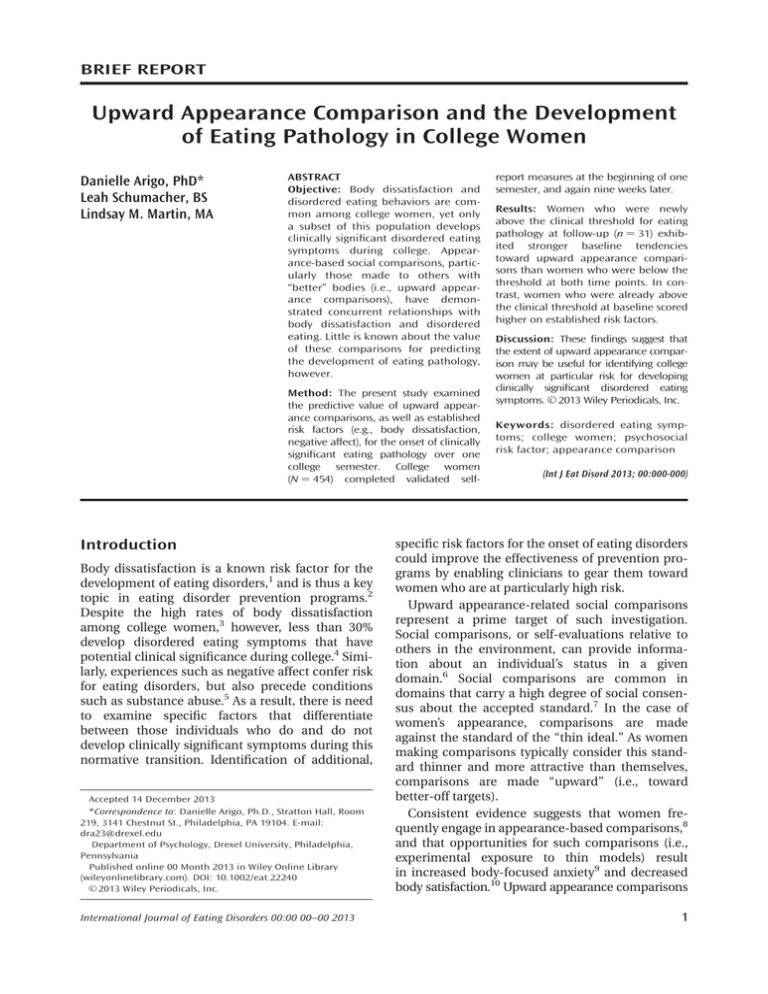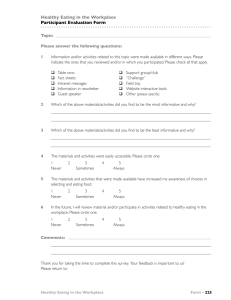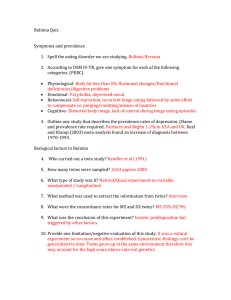Upward Appearance Comparison and the Development BRIEF REPORT Danielle Arigo, PhD*
advertisement

BRIEF REPORT Upward Appearance Comparison and the Development of Eating Pathology in College Women Danielle Arigo, PhD* Leah Schumacher, BS Lindsay M. Martin, MA ABSTRACT Objective: Body dissatisfaction and disordered eating behaviors are common among college women, yet only a subset of this population develops clinically significant disordered eating symptoms during college. Appearance-based social comparisons, particularly those made to others with “better” bodies (i.e., upward appearance comparisons), have demonstrated concurrent relationships with body dissatisfaction and disordered eating. Little is known about the value of these comparisons for predicting the development of eating pathology, however. Method: The present study examined the predictive value of upward appearance comparisons, as well as established risk factors (e.g., body dissatisfaction, negative affect), for the onset of clinically significant eating pathology over one college semester. College women (N 5 454) completed validated self- Introduction Body dissatisfaction is a known risk factor for the development of eating disorders,1 and is thus a key topic in eating disorder prevention programs.2 Despite the high rates of body dissatisfaction among college women,3 however, less than 30% develop disordered eating symptoms that have potential clinical significance during college.4 Similarly, experiences such as negative affect confer risk for eating disorders, but also precede conditions such as substance abuse.5 As a result, there is need to examine specific factors that differentiate between those individuals who do and do not develop clinically significant symptoms during this normative transition. Identification of additional, Accepted 14 December 2013 *Correspondence to: Danielle Arigo, Ph.D., Stratton Hall, Room 219, 3141 Chestnut St., Philadelphia, PA 19104. E-mail: dra23@drexel.edu Department of Psychology, Drexel University, Philadelphia, Pennsylvania Published online 00 Month 2013 in Wiley Online Library (wileyonlinelibrary.com). DOI: 10.1002/eat.22240 C 2013 Wiley Periodicals, Inc. V International Journal of Eating Disorders 00:00 00–00 2013 report measures at the beginning of one semester, and again nine weeks later. Results: Women who were newly above the clinical threshold for eating pathology at follow-up (n 5 31) exhibited stronger baseline tendencies toward upward appearance comparisons than women who were below the threshold at both time points. In contrast, women who were already above the clinical threshold at baseline scored higher on established risk factors. Discussion: These findings suggest that the extent of upward appearance comparison may be useful for identifying college women at particular risk for developing clinically significant disordered eating C 2013 Wiley Periodicals, Inc. symptoms. V Keywords: disordered eating symptoms; college women; psychosocial risk factor; appearance comparison (Int J Eat Disord 2013; 00:000-000) specific risk factors for the onset of eating disorders could improve the effectiveness of prevention programs by enabling clinicians to gear them toward women who are at particularly high risk. Upward appearance-related social comparisons represent a prime target of such investigation. Social comparisons, or self-evaluations relative to others in the environment, can provide information about an individual’s status in a given domain.6 Social comparisons are common in domains that carry a high degree of social consensus about the accepted standard.7 In the case of women’s appearance, comparisons are made against the standard of the “thin ideal.” As women making comparisons typically consider this standard thinner and more attractive than themselves, comparisons are made “upward” (i.e., toward better-off targets). Consistent evidence suggests that women frequently engage in appearance-based comparisons,8 and that opportunities for such comparisons (i.e., experimental exposure to thin models) result in increased body-focused anxiety9 and decreased body satisfaction.10 Upward appearance comparisons 1 ARIGO ET AL. also distinguish women with body dissatisfaction11 and disordered eating symptoms12 from those without, such that women with greater body dissatisfaction and disordered eating symptoms report stronger tendencies toward upward appearance comparison.13 Despite the apparent role of appearance comparisons in body dissatisfaction and eating disorders, however, little is currently known about its role as a prospective predictor in disordered eating onset. The present study examined the predictive utility of upward appearance comparisons for the onset of clinically significant disordered eating symptoms over one college semester. Method Participants As part of a larger study, college women enrolled in an introductory psychology course at a large, private university (N 5 454) participated in an online survey related to body image and social functioning. The average participant was 19 years old (SD 5 1.02) with a BMI of 23.13 kg/ m2 (SD 5 4.78). The majority of participants identified as Caucasian (60%); other ethnic backgrounds included Asian (21%), Hispanic/Latina (8%), Black/African American (7%), Native American (1%), and mixed (3%). Most participants were freshman (66%) and lived on campus with a roommate (81%). Procedure The present study was advertised through SONA, a web portal designed for scheduling and tracking research participation. Those who were interested in participating were offered a link to an online survey, where they gave electronic informed consent. Participants completed the same set of measures at the start and end of one semester (nine weeks later). At both time points, participants completed the survey in one sitting, at their convenience. All procedures were approved by the supporting university’s Institutional Review Board. Measures Eating Disorder Examination Questionnaire: The EDEQ14 is a 26-item measure of disordered eating behaviors and thoughts over the past month (e.g., restricting food intake, fear of being or becoming “fat”). This measure has an established cutoff score of 2.30 for clinically significant symptomatology. In the present study, estimated internal consistency (Cronbach’s alpha) was 0.95. Body Image Disturbance Questionnaire: The BIDQ15 is a 7-item assessment of general body dissatisfaction, concern about appearance, and associated distress. Items related to concern about appearance are rated on a scale 2 of 1 (not at all) to 5 (extremely). Cronbach’s alpha for the present study was 0.91. Positive and Negative Affect Schedule: The Negative Affect subscale of the PANAS16 is a 10-item measure of negative emotions experienced over the past month (e.g., guilt, irritability). Emotions are rated on a scale of 1 (very slightly/not at all) to 5 (extremely). In the present study, Cronbach’s alpha was 0.88. Upward Appearance Comparison Scale: The UPACS13 is an 11-item questionnaire that assesses the extent of upward comparisons based on appearance domains (i.e., comparisons to others perceived to be more attractive than the self). Items such as “I compare myself to those who are better looking than me” are rated on a scale of 1 (strongly disagree) to 5 (strongly agree). Cronbach’s alpha for the present study was 0.92. Statistical Approach We hypothesized that women who were below an accepted threshold for self-reported disordered eating symptoms at baseline and above that threshold at follow-up (i.e., those newly above the threshold at follow-up) would endorse greater upward appearance comparisons than women who were below the clinical threshold at both time points. This hypothesis was tested using a planned contrast (ANOVA) corrected for unbalanced group sizes. Conversely, we predicted that women who were above the accepted threshold for clinically significant disordered eating symptoms at baseline would endorse greater body dissatisfaction and negative affect than those below the threshold (ANOVA with planned contrast). Finally, the predictive value of upward appearance comparisons also was compared to that of established risk factors in a generalized logit model. Results Approximately 61% of the present sample (n 5 278) fell below the accepted EDE-Q clinical cutoff for disordered eating symptoms at both time points, indicating no evidence of significant pathology during the semester. In contrast, 24% of the sample (n 5 110) scored above the clinical cutoff at both time points, suggesting that these women experienced significant pathology throughout the semester. The composition of the present sample thus roughly reflected available prevalence estimates for the general population of college-aged women.4, 17 Of particular interest were participants who: (1) began the semester below the EDE-Q clinical threshold, but were above the clinical threshold at the end of the semester (n 5 31; 7% of the sample), and (2) began the semester above the EDE-Q clinical threshold, but were below the clinical threshold International Journal of Eating Disorders 00:00 00–00 2013 UPWARD APPEARANCE COMPARISON AND ED SYMPTOMS TABLE 1. Descriptions of categories based on clinically meaningful change on the EDE-Q over nine weeks N Definition Change in EDE-Q Score Remained below clinical cutoff Category 278 t[277] 5 20.70, p < .48 Above clinical cutoff at both time points 110 Participants with EDE-Q total scores < 2.30 at baseline and follow-up Participants with EDE-Q total scores > 2.30 at baseline and follow-up Participants with EDE-Q total scores < 2.30 at baseline and > 2.30 follow-up Participants with EDE-Q total scores > 2.30 at baseline and < 2.30 follow-up Newly above the clinical cutoff at follow-up 31 Newly below the clinical cutoff at follow-up 38 TABLE 2. Baseline Post Change t[37] 5 29.52, p < .0001 0.96 (0.63) 11.46 (3.95) 19.89 (6.79) 2.67 (0.84) 0.95 (0.64) 11.46 (4.14) 19.89 (6.60) 2.57 (0.79) 20.02 (0.46) 0.04 (3.12) 20.27 (6.58) 20.08 (0.69) Above clinical cutoff at both time points EDE-Q BIDQa NAa UPACS Baseline Post Change 3.51 (0.82) 19.23 (5.41) 25.15 (7.64) 3.52 (0.55) 3.63 (0.90) 19.39 (5.42) 24.88 (7.75) 3.50 (0.54) 0.11 (0.75) 0.12 (4.90) 20.45 (7.72) 0.15 (0.71) Newly above the clinical cutoff at follow-up EDE-Q BIDQ NA UPACSb t[30] 5 9.00, p < .0001 Baseline, follow-up, and change scores on study measures by EDE-Q change category Below clinical cutoff at both time points EDE-Q BIDQ NA UPACS t[109] 5 21.62, p < .11 Baseline Post Change 1.55 (0.60) 14.20 (0.42) 23.82 (7.39) 3.73 (0.42) 3.83 (0.44) 16.77 (5.00) 24.12 (7.73) 3.86 (0.43) 1.28 (0.79) 2.73 (5.78) 0.38 (7.48) 0.14 (0.41) Newly below the clinical cutoff at follow-up EDE-Q BIDQ NA UPACS Baseline Post Change 2.79 (0.49) 15.61 (3.74) 24.13 (5.42) 3.09 (0.54) 1.57 (0.72) 13.89 (3.76) 21.09 (6.26) 2.67 (0.64) 21.22 (0.79) 21.71 (4.30) 23.04 (7.55) 20.12 (0.41) Notes: EDE-Q 5 Eating Disorders Examination Questionnaire (disordered eating symptoms); BIDQ 5 Body Image Disturbance Questionnaire (body dissatisfaction and associated distress); NA 5 Negative Affect scale of the PANAS; UPACS 5 Upward Physical Appearance Comparison Scale. a BIDQ and NA scores for women above the EDE-Q clinical cutoff at baseline were significantly higher than those of women who were below the clinical cutoff at baseline (ps < .05). b UPACS scores for women who were newly above EDE-Q clinical cutoff at follow-up were significantly higher than scores for women who stayed below the clinical cutoff at both time points (p 5 .019). at the end of the semester (n 5 38; 8% of the sample). Both groups demonstrated statistically significant change in EDE-Q score from baseline to follow-up (ps < .001; see Table 1). None of the participants who were newly below the clinical threshold at the end of the semester reported receiving mental health treatment between baseline and follow-up. Mean baseline scores on all study measures for each subgroup are presented in Table 2. Examination of known risk factors for the development of clinically significant disordered eating symptoms revealed baseline differences in both body dissatisfaction (F[3,451] 5 87.92, p < .001, g2p 5 0.37) and negative affect (F[3,451] 5 9.35, p < .001, g2p 5 0.10) between EDE-Q change subgroups. However, baseline scores were higher among participants who exceeded the EDE-Q clinical cutoff at baseline, relative to those who did not (ps < .05; dBIDQ 5 0.94, dNA 5 0.29). This pattern shows that individuals already in the clinical range of disordered eating symptoms exhibited greater body dissatisfaction and negative affect at baseline, and thus highlights these variables as maintenance as well as risk factors for disordered eating. International Journal of Eating Disorders 00:00 00–00 2013 EDE-Q subgroups also displayed baseline differences in their extent of upward appearance comparison (F[3,451] 5 7.95, p < .001, g2p 5 0.19). Participants who were newly above the clinical threshold at the end of the semester showed the strongest tendencies toward upward appearance comparison; scores for this group were significantly higher than those of participants who stayed below the clinical cutoff throughout the semester (contrast F 5 5.69, p 5 .019, d 5 0.51; see Table 2). A non-parametric regression model that included body dissatisfaction, negative affect, and upward appearance comparison also showed that upward appearance comparison significantly differentiated EDE-Q subgroups when known risk factors were controlled (Wald v2 5 5.96, p 5 .003; estimate 50.05, 95% CI 5 20.18 to 0.29). Discussion Existing evidence demonstrates that appearancefocused social comparisons, particularly those made toward others perceived to be better looking 3 ARIGO ET AL. (i.e., upward appearance comparisons), play a key role in body dissatisfaction and consequent disordered eating behaviors.11,12 To the authors’ knowledge, however, upward appearance comparison has not been examined as a prospective predictor of clinically significant disordered eating symptoms. The present study extends previous work in this area by testing the predictive value of upward appearance comparisons for the onset of eating pathology in a large sample of college women. Findings indicate that 7% of the sample developed significant eating pathology over the course of one semester, and that these women demonstrated greater tendencies toward upward appearance comparison at the start of the semester (relative to women who did not develop eating pathology). In contrast, established risk factors (i.e., negative affect and body dissatisfaction)1 were higher among women who evidenced eating pathology at baseline (relative to those who were newly above the clinical threshold at followup). These findings thus demonstrate the potential utility of upward appearance comparisons for identifying college women at particular risk for the onset of clinically significant disordered eating symptoms. As noted, experimentally presented opportunities for upward appearance comparisons result in immediate increases in body dissatisfaction;10 the appearance comparison measure used in the present study, however, assesses an individual’s tendency to make such negative comparisons in everyday life.13 Consequently, scores on this measure convey the extent to which respondents are exposed to negative perceptions of their bodies. The cumulative effect of repeated exposure to negative body perceptions may play a key role in the acceleration of global body dissatisfaction and associated distress,11 thereby potentiating meaningful increases in disordered eating symptoms. Additional research will be necessary to clarify the temporal sequence of experiences that confer risk and the optimal period for prevention efforts. The present study was limited by reliance on self-report, a sample recruited from a single university, and lack of long-term follow-up. Although the measure used to assess disordered eating in the present study has an established clinical threshold, additional research is needed to confirm these findings using clinician-administered assessment techniques. This work would benefit from recruiting a nationally representative sample and additional assessment points (for which the present study did not have the necessary resources), as well as determination of thresholds for disordered eating risk based on measures of upward appearance 4 comparison. In addition, only a limited number of experiences relevant to disordered eating were assessed in this study. Therefore, it is possible that participants who developed disordered eating symptoms differed from other groups not only on baseline upward appearance comparison, but related experiences not captured here (e.g., extent of weight-related teasing, exposure to thin ideal images). Despite these limitations, however, the current findings provide preliminary evidence to suggest that a greater focus on upward appearance comparisons may contribute to improvement of eating disorder prevention on college campuses. References 1. Stice E. Risk and maintenance factors for eating pathology: A meta-analytic review. Psychol Bull 2002;128:825. 2. Stice E, Marti CN, Spoor S, Presnell K, Shaw H. Dissonance and healthy weight eating disorder prevention programs: Long-term effects from a randomized efficacy trial. J Consult Clin Psychol 2008;76:329. 3. Cash TF. Women’s body images. In: Wingood G, DiClemente R, editors. Handbook of Women’s Sexual and Reproductive Health. New York: Plenum, 2002, pp. 175–194. 4. Luce KH, Crowther JH, Pole M. Eating Disorder Examination Questionnaire (EDE-Q): Norms for undergraduate women. Int J Eat Disord 2008;41:273– 276. 5. Measelle JR, Stice E, Springer DW. A prospective test of the negative affect model of substance abuse: Moderating effects of social support. Psychol Addict Behav 2006;20:225. 6. Festinger L. A theory of social comparison processes. Hum Relations 1954;7: 117–140. 7. Tajfel H, Billig MG, Bundy RP, Flament C. Social categorization and intergroup behaviour. Eur J Soc Psychol 1971;1:149–178. 8. Leahey TM, Crowther JH, Mickelson KD. The frequency, nature, and effects of naturally occurring appearance-focused social comparisons. Behav Ther 2007;38:132–143. 9. Friederich H, Uher R, Brooks S, Giampietro V, Brammer M, Williams SCR. I’m not as slim as that girl: Neural bases of body shape self-comparison to media images. NeuroImage 2007;37:674–681. 10. Groesz LM, Levine MP, Murnen SK. The effect of experimental presentation of thin media images on body satisfaction: A meta-analytic review. Int J Eat Disord 2002;31:1–16. 11. Myers TA, Crowther JH. Social comparison as a predictor of body dissatisfaction: A meta-analytic review. J Abnorm Psychol 2009;118:683. 12. Corning AF, Krumm AJ, Smitham LA. Differential social comparison processes in women with and without eating disorder symptoms. J Counsel Psychol 2006;53:338. 13. O’Brien KS, Caputi P, Minto R, Peoples G, Hooper C, Kell S, Sawley E. Upward and downward physical appearance comparisons: Development of scales and examination of predictive qualities. Body Image 2009;6:201–206. 14. Cooper Z, Cooper PJ, Fairburn CG. The validity of the eating disorder examination and its subscales. Br J Psychiatry 1989;154:807–812. 15. Cash TF, Phillips KA, Santos MT, Hrabosky JI. Measuring “negative body image”: validation of the Body Image Disturbance Questionnaire in a nonclinical population. Body Image 2004;1:363–372. 16. Watson D, Clark LA, Tellegen A. Development and validation of brief measures of positive and negative affect: The PANAS scales. J Pers Soc Psychol 1988;54:1063. 17. Mond JM, Hay P, Rodgers B, Owen C. Eating Disorder Examination Questionnaire (EDE-Q): Norms for young adult women. Behav Res Ther 2006;44:53– 62. International Journal of Eating Disorders 00:00 00–00 2013





